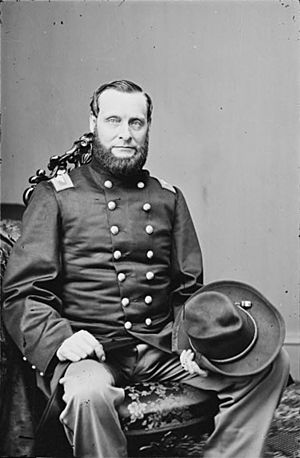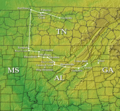Abel Streight facts for kids
Quick facts for kids
Abel Delos Streight
|
|
|---|---|

Abel D. Streight
|
|
| Born | June 17, 1828 Wheeler, New York |
| Died | May 27, 1892 (aged 63) Indianapolis, Indiana |
| Place of burial |
Crown Hill Cemetery
|
| Allegiance | United States of America Union |
| Service/ |
United States Army Union Army |
| Years of service | 1861 - 1865 |
| Rank | |
| Commands held | 51st Indiana Infantry Regiment Horn Brigade |
| Battles/wars | American Civil War |
Abel Delos Streight (born June 17, 1828 – died May 27, 1892) was an important figure during the American Civil War. Before the war, he was a businessman who sold lumber and published books. During the war, he became a Union Army colonel.
Colonel Streight is best known for leading a daring mission in 1863 called Streight's Raid. He was captured during this raid and spent 10 months as a prisoner of war. After the war, he was honored with the rank of brevet brigadier general. He later became a state senator in Indiana, serving two terms.
Contents
Abel Streight's Early Life
Abel Streight was born in Wheeler, New York. His parents were Asa and Lydia Spaulding Streight. In 1849, he married Lavina McCarty. She was born in New York in 1830.
As a young man, Abel moved to Cincinnati. By 1859, he was living in Indianapolis. There, he worked as a publisher, creating books and maps.
Joining the Civil War
When the Civil War began, Abel Streight joined the Union Army. On December 12, 1861, he was made a colonel. He led the 51st Indiana Infantry regiment. His regiment became part of the Union Army of the Cumberland.
For the first two years, Streight and his regiment did not see much fighting. This made him eager for more action.
Streight's Daring Raid
In 1863, Colonel Streight suggested a bold plan. He wanted to lead a force deep into the South. His goal was to cut off the Western and Atlantic Railroad. This railroad carried supplies to the Confederate Army of Tennessee. The Union Army commander, William S. Rosecrans, approved his plan.
Streight gathered about 1,700 soldiers for this mission. These troops came from his own 51st Indiana, the 73rd Indiana, the 80th Illinois, and the 3rd Ohio Infantry regiments. The plan was for them to travel quickly. However, due to wartime shortages, they were given mules instead of horses. This made their journey much harder.

Streight's force left Tuscumbia, Alabama, on April 26, 1863. They headed southeast. On April 30, they met a Confederate cavalry force. This force was led by Nathan Bedford Forrest. Forrest's troops chased and fought Streight's men for several days. Streight's force won the Battle of Day's Gap. However, many smaller fights followed. Eventually, Streight's Union forces were surrounded.
On May 3, 1863, Colonel Streight was captured at Cedar Bluff, Alabama. He was taken to Libby Prison as a prisoner of war.
Escape from Prison
After being held for ten months, Streight made a daring escape. On February 9, 1864, he and 107 other soldiers dug a tunnel. They tunneled from their barracks to freedom. Streight managed to travel through enemy territory. He eventually returned to Union lines. He then reported his experiences to his commanders.
Returning to Duty
After his escape, Streight was put back on active duty. He was given command of the 1st Brigade. This unit was part of the IV Corps. He fought in important battles like the Battle of Franklin and the Battle of Nashville. Streight left the army on March 16, 1865.
In 1866, President Andrew Johnson honored Streight. He nominated him to be a brevet brigadier general. This special rank was confirmed by the United States Senate.
Life After the War
In 1866, Streight and his wife, Lovina, built a house in Indianapolis. In 1876, Streight successfully ran for a seat in the Indiana Senate. He served for two years. In 1880, he tried to become governor of Indiana but did not win.
In 1888, he was elected as a State Senator again. He died four years later in 1892. He passed away from complications of Bright's Disease, a kidney illness. He was first buried at his home. Later, in 1902, his grave was moved to Crown Hill Cemetery. His grave has a bronze statue of him.
Streight also wrote a book. It was called The Crisis of Eighteen Hundred and Sixty-one in the Government of the United States. It was published in 1861.
Lovina Streight: "Mother of the 51st"
Abel's wife, Lovina, was also very brave. She joined her husband during his campaigns in the South. She often helped wounded soldiers. The soldiers called her "The Mother of the 51st" because of her care.
Lovina was captured three times by Confederate soldiers. Twice, she was exchanged for other prisoners. The third time, she managed to escape. When Abel died, she had him buried in their front yard. She said, "I never knew where he was in life, but now I can find him."
When Lovina Streight died in 1910, she received full military honors. Her funeral was one of the largest at Crown Hill Cemetery since President Benjamin Harrison's funeral. In her will, she wanted their home to become a place for older women. However, relatives challenged her will.
Images for kids





